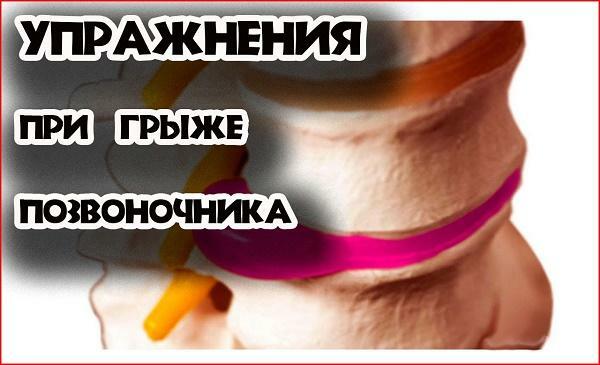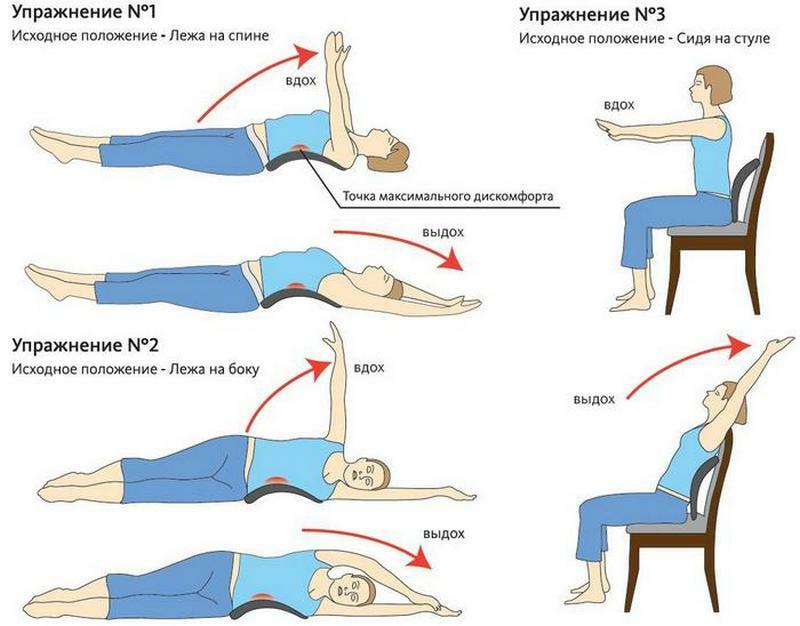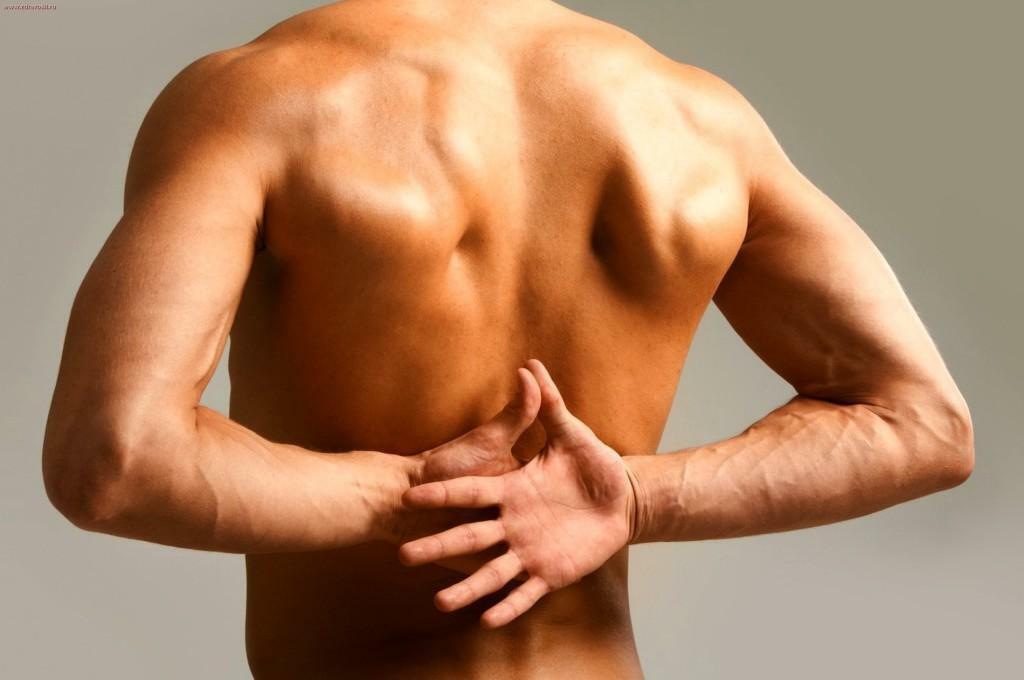When a hernia of the lumbar spine is diagnosed in a person, complex treatment is needed, including not only the intake of special preparations, but also physical therapy, which is an integral part of effective therapy. Thus, the use of exercise therapy can prevent the need for surgical treatment, reduce the risk of complications and relieve from periods of exacerbation. Thanks to special medical exercises, you can relieve the load from the back, stop pain in the spine and regain lost flexibility, which worsens mobility.
Therefore, if a person is disturbed by a hernia in the vertebral column, it is very important to regularly perform the correct exercises. There are several complex exercises that are performed during periods of exacerbation and remission that will help restore normal vital activity in this diagnosis( they can be found further in the article).

Lumbar Spinal Exercise Complex
Content of the material
- 1 Exercises for the exacerbation period
-
2 Training in the remission period
- 2.1 Video - Exercises for the lumbar spine
- 2.2 Video - Therapeutic exercises for hernia of the lumbar spine
- 2.3 Video - Two versatileexercises with a hernia in the lumbar spine
- 3 The basic rules of training
- 4 Why exercise is necessary for treatment of the intervertebral hernia?
- 5 What is strictly forbidden?
Exercises for the period of exacerbation of
If the intervertebral hernia has worsened, and the patient's state of health has worsened, it is recommended to go to the LFK.Moreover, it is necessary to pay attention that during the exacerbation of the disease only a limited number of exercises are performed. These exercises provide a supine position on the back, since the spine is completely unloaded in this position, while the pressure inside the discs decreases.
Warning! If there is an exacerbation of the intervertebral hernia, then it is forbidden to perform rotational and kyphosic exercises. That is, those that provide bending or turning the spine, since the probability of disc displacement is high.
When starting exercises, remember that all manipulations are repeated five to fifteen times. After each approach, rest is required( deep breathing in the supine position exactly on the back).

Herniated disc
| Initial position of the body | Short description of the action |
|---|---|
| The person lies on the back | For five seconds, you need to pull the lower extremity socks away from yourself, then for the next five seconds to yourself |
| The person lies on the back | The patient remains lying on his back,but the left leg is raised about 20 centimeters above the floor and is held for about ten seconds, after which the legs change |
| The person lies on the back | The legs bend at the knees and then the heels are loweredI have the most to the buttocks( note that the foot can not be separated from the floor).Then the limbs too slowly unbend and return to their original position |
| The person remains lying on his back, but already with knees bent in the knees and with heels pressed to the buttocks, as described in the previous exercise | . While performing this exercise, it is allowed to help with hands, so you can grab a littleknee with your hands. It turns out that the right leg in a bent form is pulled to the chest, then completely returns to its original position. In this case, be sure to keep your back exactly, and maximally press it to the floor. Similar actions are performed with the left foot |
Attention! Each time when selecting a set of exercises, it is necessary to consult with the attending physician in order to avoid exacerbation of the clinical picture.

Exercises for lumbar department
Training in remission period
If the intervertebral hernia is outside of exacerbation, then to exercises in a lying posture, you can add manipulations on all fours. This set of exercises is aimed at stretching the spine by stretching and bending, as well as turning. All manipulations are performed five to fifteen times.
Caution! The above movements are contraindicated in case of exacerbation, but in this case should be performed smoothly and slowly.
| In which starting position is the patient | Brief description of the exercise |
|---|---|
| The person lies exactly on the back | It is necessary to raise your legs, bend them in your knees and imagine cycling, thus you get a virtual scrolling of the pedals |
| The person remains lying on his back, but withbent in the knees of the limbs and with the heels pressed to the buttocks( this posture was in the exercise of exacerbation of the hernia) | The exercise differs in that the arms are not clasped by one leg, and both( behind the knees) and tnetsya to his chest, while the chin is necessary to try to reach the knees. As a result, it turns out that the patient folds into a glomerulus lying on his back. In this position, the body should be fixed for five minutes. After the time has expired, slowly return to the initial position |
| The patient becomes on all fours | The exercise is performed in conjunction with breathing. It is necessary to maximally bend and bend the backbone on all fours. At the deflection, you need to tilt the head a little |
| The patient becomes on all fours | The person pulls out his left hand and raises his right leg - in this position he tries to hold for ten seconds, and then does similar actions with other limbs |
| The patient becomes on all fours | The person remains standingon all fours, but at the same time he tilts the basin to the right and sits down, then to the left and sit down again. Exercise is performed up to five times on each side of the |
| . The patient becomes on all fours. | The head tilts down as far as possible and the right knee extends to it, the leg changes and now the left knee reaches the head. Performed for eight seconds per foot |
| The patient becomes on all fours | The person remains standing in the starting position, pulls the pelvis as far back and tries to sit on the heels, then returns to the original one. Repeat ten such manipulations |
It is recommended to revise several video lessons, which clearly shows effective exercises for the lumbar part of the intervertebral hernia.
Video - Exercises for the lumbar spine
Video - Therapeutic exercises with a hernia of the lumbar spine
Video - Two universal exercises with a hernia in the lumbar spine
Basic rules of training
- All exercises must be held or supervised by the trainer of the exercise therapy, or by agreement. Also, before performing exercise therapy, you must first get a consultation from an orthopedist and neurologist who should be familiar with the patient's anamnesis. Directly the coach needs to clarify all prohibited exercises and ask to check the correctness of the performance of all assigned manipulations. It is not ruled out that with the intervertebral hernia in a particular case, it may be contraindicated by exercise therapy.
- All the load on the spine should increase gradually, that is, the length of the session and its complexity should increase proportionally. Categorically contraindicated in the intervertebral hernia exercises, which consist of intensive loads.
- Beginning of exercise therapy follows from the most elementary exercises for five minutes and with each lesson to increase the time by one minute.
- It is very important that the actions are without sudden movements, because in this way you can significantly exacerbate the condition.
- Complex LFK should include manipulations for different departments of the back( tonic) and an exercise aimed at treating lumbar spine. As a result, it is possible to make the load not only reinforcing, but also integral.
- All workouts should be done effortlessly and with ease. If the pain in the back begins to increase, then urgently need to give up lessons. Also, exercise should not provoke the onset of pain syndrome. If the pain in the back is present, then the load should be minimal.

Complex of exercises for back pain
Recommended! Each time consult with the leading instructor of exercise therapy and observe the orthopedist's changes( regress or progress of the disease).
Why is therapeutic exercises necessary for the intervertebral hernia?
To accelerate recovery, an active blood supply to the spinal tissues is required, which is improved by the action of the load. In addition, the muscular corset is strengthened and the load on the lumbar region is minimized.
Pathological processes in the spine occur due to metabolic disturbances, so physical exercises are simply necessary if the patient has a diagnosis of an intervertebral hernia. Muscles begin to atrophy when the motor process is insufficient, on the basis of what, the ailment will only begin to progress.
The spine requires a strong muscular corset to hold it, if the muscles are atrophied, then this ability is absent and the discs are deformed, which greatly exacerbates the clinical picture. The weakened muscle corset is unable to hold the correct position of the spine, so the discs are pathological processes. Consequently, all loads will fall on the bone tissue, as well as cartilage tissue.

Gymnastics for the lumbar spine
What's strictly forbidden?
It is necessary to pay attention to a number of limitations in the intervertebral hernia. First of all, the beginning of exercise should be only during remission. At first the patient must perform all the exercises under the guidance of the trainer. Since the intervertebral hernia is a pathological lesion, in which any movement is accompanied by serious complications.
With an incautious sharp turn, even a slight displacement of the disc may occur, which will result in pressure on the nerve endings, followed by damage to the spinal cord. And so, a person with a diagnosis of intervertebral lumbar hernia is prohibited:
- Exercises should be performed with ease, so any pain or difficulty should be absent.
- The initial stages of exercise therapy exclude twisting.
- Do not jump or manipulate the lumbar region.
- No sudden movements.
- Begin with minimal loads, because the increased loads can lead to completely opposite results.



